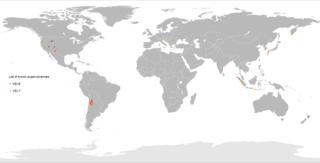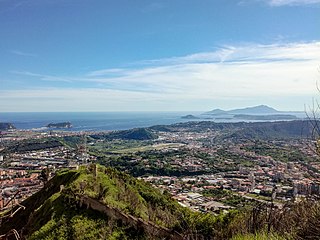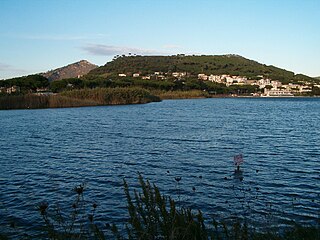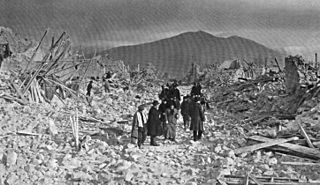
A supervolcano is a volcano that has had an eruption with a volcanic explosivity index (VEI) of 8, the largest recorded value on the index. This means the volume of deposits for such an eruption is greater than 1,000 cubic kilometers.

A volcano is a rupture in the crust of a planetary-mass object, such as Earth, that allows hot lava, volcanic ash, and gases to escape from a magma chamber below the surface. The process that forms volcanoes is called volcanism.

Mount Vesuvius is a somma–stratovolcano located on the Gulf of Naples in Campania, Italy, about 9 km (5.6 mi) east of Naples and a short distance from the shore. It is one of several volcanoes forming the Campanian volcanic arc. Vesuvius consists of a large cone partially encircled by the steep rim of a summit caldera, resulting from the collapse of an earlier, much higher structure.

A fumarole is a vent in the surface of the Earth or another rocky planet from which hot volcanic gases and vapors are emitted, without any accompanying liquids or solids. Fumaroles are characteristic of the late stages of volcanic activity, but fumarole activity can also precede a volcanic eruption and has been used for eruption prediction. Most fumaroles die down within a few days or weeks of the end of an eruption, but a few are persistent, lasting for decades or longer. An area containing fumaroles is known as a fumarole field.
A volcano observatory is an institution that conducts research and monitoring of a volcano.

Bradyseism is the gradual uplift or descent of part of the Earth's surface caused by the filling or emptying of an underground magma chamber or hydrothermal activity, particularly in volcanic calderas. It can persist for millennia in between eruptions and each uplift event is normally accompanied by thousands of small to moderate earthquakes. The word derives from the ancient Greek words βραδύςbradús, meaning "slow", and σεισμόςseismós meaning "movement", and was coined by Arturo Issel in 1883.

Solfatara is a shallow volcanic crater at Pozzuoli, near Naples, part of the Phlegraean Fields volcanic area. It is a dormant volcano, which still emits jets of steam with sulfurous fumes. The name comes from the Latin, Sulpha terra, "land of sulfur", or "sulfur earth". It was formed around 4000 years ago and last erupted in 1198 with what was probably a phreatic eruption – an explosive steam-driven eruption caused when groundwater interacts with magma. The crater floor was a popular tourist attraction until 2017, as it has many fumaroles and mud pools. The area is well known for its bradyseism. The vapours had been used for medical purposes since Roman times.

The Yellowstone Caldera, sometimes referred to as the Yellowstone Supervolcano, is a volcanic caldera and supervolcano in Yellowstone National Park in the Western United States. The caldera and most of the park are located in the northwest corner of the state of Wyoming. The caldera measures 43 by 28 miles, and postcaldera lavas spill out a significant distance beyond the caldera proper.

The volcanism of Italy is due chiefly to the presence, a short distance to the south, of the boundary between the Eurasian Plate and the African Plate. Italy is a volcanically active country, containing the only active volcanoes in mainland Europe. The lava erupted by Italy's volcanoes is thought to result from the subduction and melting of one plate below another.

The Phlegraean Fields is a large caldera volcano west of Naples, Italy. It is part of the Campanian volcanic arc, which includes Mount Vesuvius, about 9 km east of Naples. The Phlegraean Fields is monitored by the Vesuvius Observatory. It was declared a regional park in 2003.

An active volcano is a volcano that has erupted during the Holocene, is currently erupting, or has the potential to erupt in the future. A volcano that is not currently erupting but could erupt in the future is known as a dormant volcano. Volcanoes that will not erupt again are known as extinct volcanoes.

Piperno is a magmatic rock present in areas where there has been volcanic activity. Piperno abounds in Campania; the areas from which it was obtained were the city of Quarto, Soccavo, Pianura and Nocera Inferiore in the supervolcano region of the Phlegraean Fields. The Piperno layer, with the overlying Breccia Museo, is clearly visible at the base of the Camaldoli hill, in the Soccavo and Verdolino areas.

Monte Nuovo is a cinder cone volcano within the Campi Flegrei caldera, near Naples, southern Italy. A series of damaging earthquakes and changes in land elevation preceded its only eruption, during the most recent part of the Holocene, which lasted from September 29 to October 6, 1538, when it was formed. The event is important in the history of science because it was the first eruption in modern times to be described by a large number of witnesses. The eruptive vent formed next to the medieval village of Tripergole on the shores of the then-much larger Lake Lucrino. The thermal bath village, which had been inhabited since ancient Roman times and was home to notable Roman-era buildings including Cicero's villa, was completely buried by ejecta from the new cinder cone. Tripergole's ruins and its important thermal springs completely disappeared under Monte Nuovo such that the exact location of the village can no longer be identified.
Running beneath the Italian city of Naples and the surrounding area is an underground geothermal zone and several tunnels dug during the ages. This geothermal area is present generally from Mount Vesuvius beneath a wide area including Pompei, Herculaneum, and from the volcanic area of Campi Flegrei beneath Naples and over to Pozzuoli and the coastal Baia area. Mining and various infrastructure projects during several millennia have formed extensive caves and underground structures in the zone.

The Campanian volcanic arc is a volcanic arc that consists of a number of active, dormant, and extinct volcanoes in the Campania region of Italy. The Campanian volcanic arc centers on the bay of Naples and includes:

Mount Barbaro or Mount Gauro in Italy Monte Barbaro or Monte Gauro, is one of the eruptive vents of the Phlegraean Fields, a volcanic field of Italy located in Campania.

The Macellum of Pozzuoli was the macellum or market building of the Roman colony of Puteoli, now the city of Pozzuoli in southern Italy. When first excavated in the 18th century, the discovery of a statue of Serapis led to the building being misidentified as the city's serapeum or Temple of Serapis.

The Campanian Ignimbrite eruption was a major volcanic eruption in the Mediterranean during the late Quaternary, classified 7 on the Volcanic Explosivity Index (VEI). The event has been attributed to the Archiflegreo volcano, the 12-by-15-kilometre-wide caldera of the Phlegraean Fields, located 20 km (12 mi) west of Mount Vesuvius under the western outskirts of the city of Naples and the Gulf of Pozzuoli, Italy. It is the largest explosive volcanic event in Europe in the past 200,000 years, and the largest eruption of Campi Fleigrei caldera.

The Vesuvius red zone is the area designated to be quickly evacuated within a few days in the case of an eruption of Mount Vesuvius. The authorities believe that they will have two weeks' warning of an imminent eruption; the questions that arise are whether the population can be evacuated in time, despite a reluctance to leave their homes; and if there be as much as two weeks' warning in reality.

According to The World Factbook, the main natural phenomena posing a threat in Italy at a regional level are landslides, mudflows, avalanches, earthquakes, volcanic eruptions, floods and, in Venice, subsidence.
















